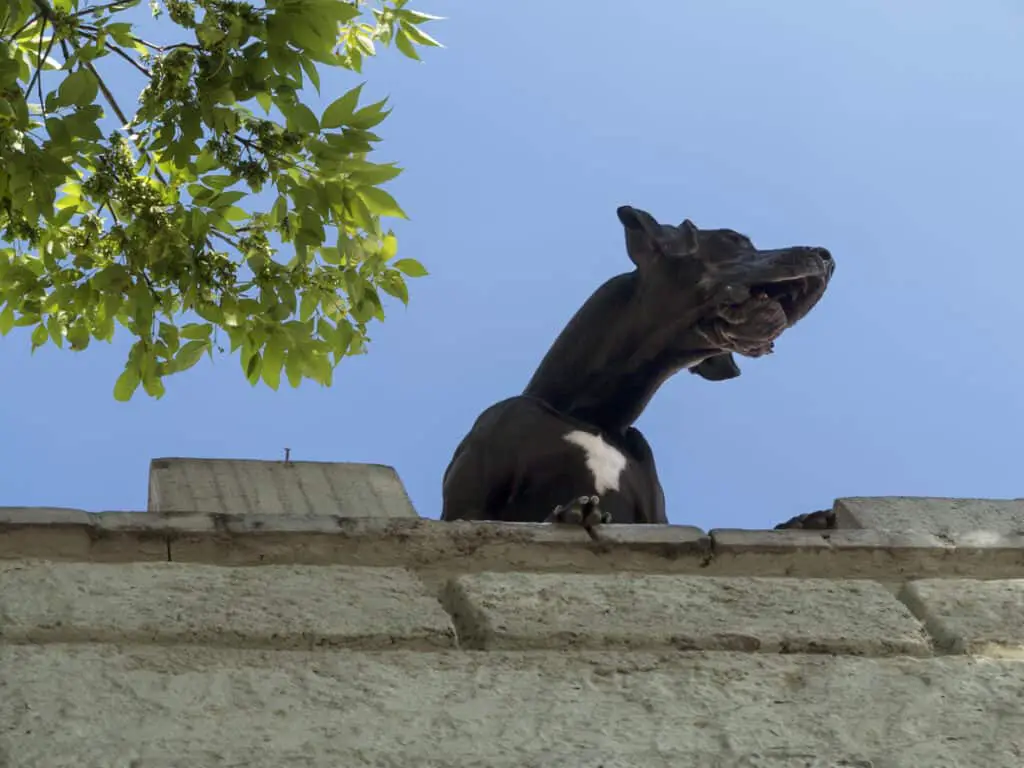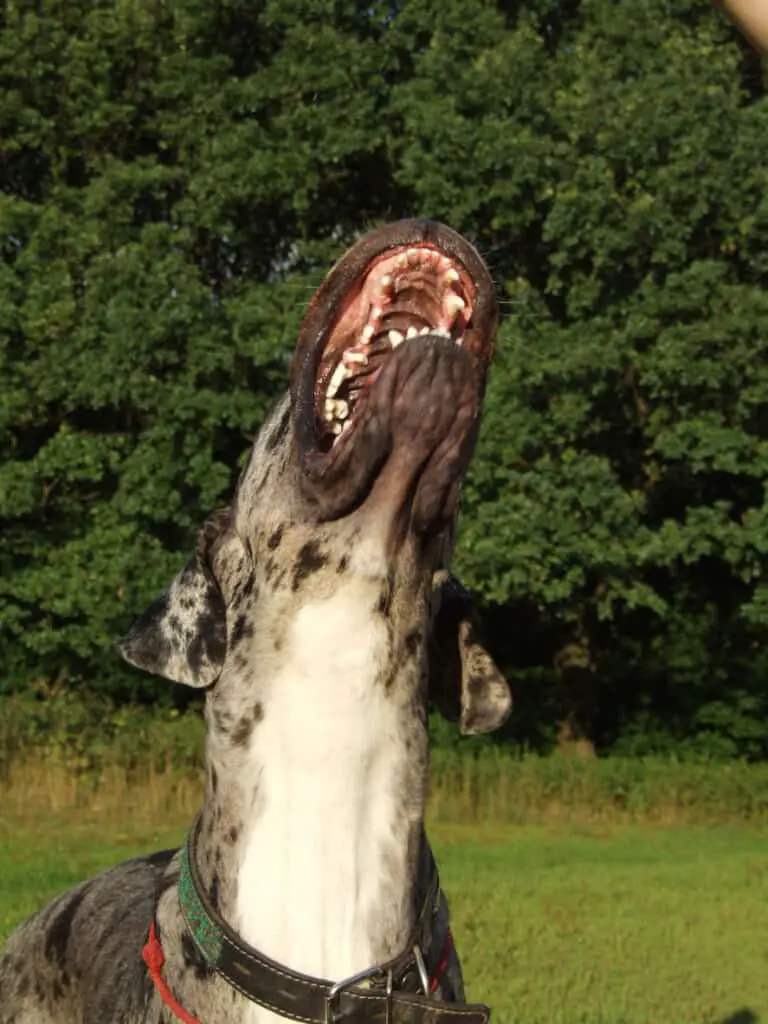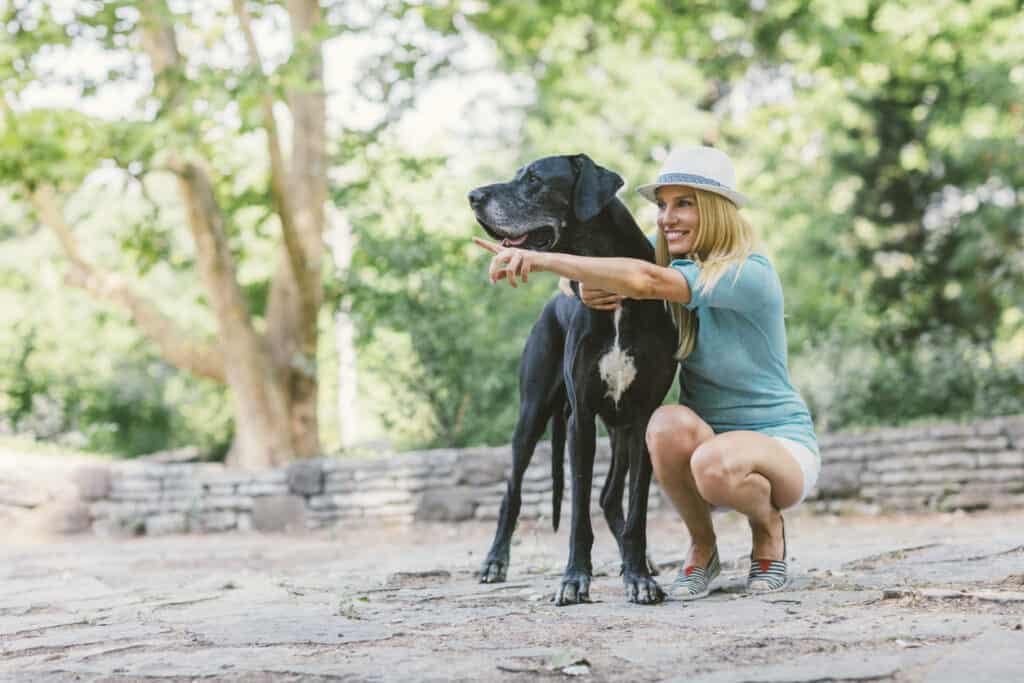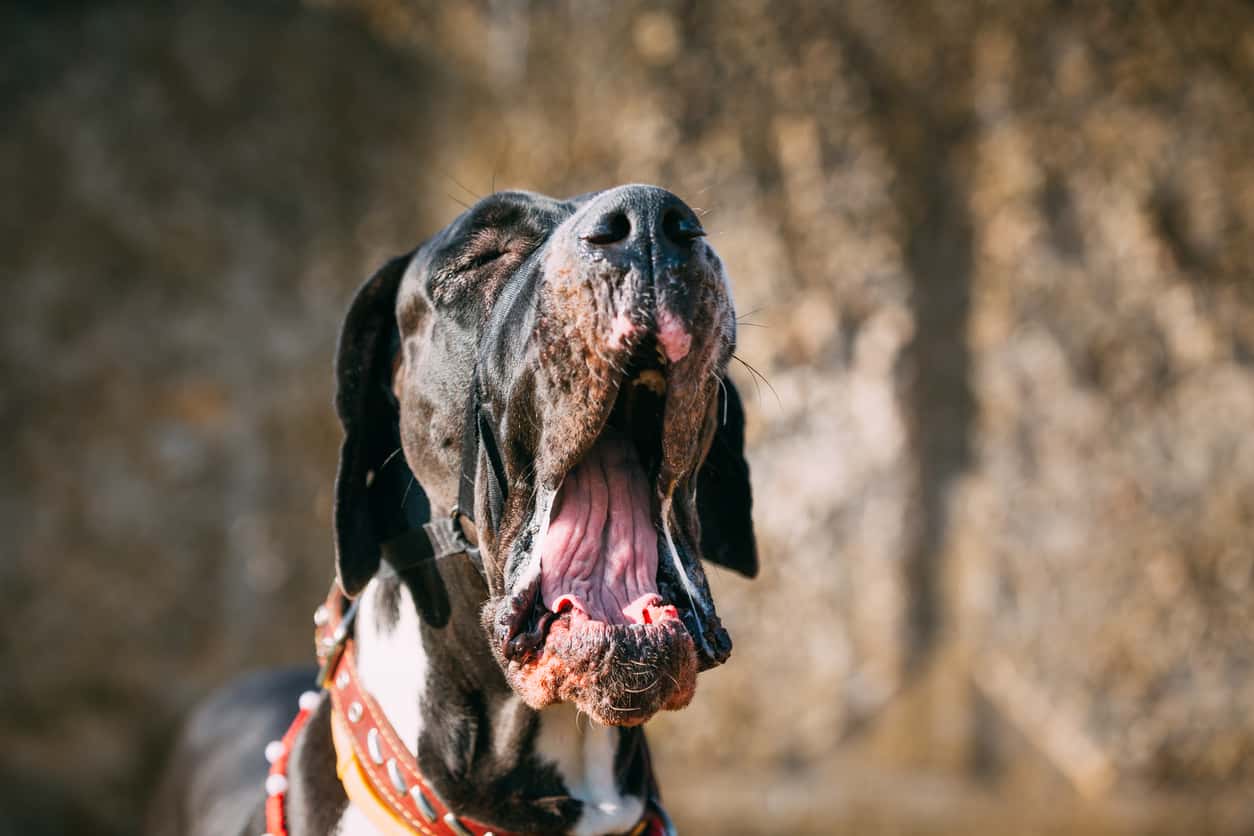Great Dane are known for many things, and barking is sometimes one of them. This ancient breed dates back to medieval Germany and was used to chase and hold boar for their masters to finish off during hunts. Eventually, the breed became used more for guarding purposes and the introduction of English Mastiff and Irish Wolfhound genes helped to create the docile, lovable, and protective gentle giant we know and love today.

Although they don’t bark very often, when they do, Great Danes certainly have a loud one. Barking can often begin during play as a puppy, where the excited Great Dane yaps in excitement during a particularly intense round of frisbee or fetch. The breed also tends to be naturally communicative and boisterous in their youth, meaning that they can become easily excited and show their excitement with sharp yaps or loud barks.
While barking is a natural behavior and should not be completely discouraged (it would be, for example, useful for your Great Dane to bark and wake you up in the case of an intruder or other emergency), it should be carefully regulated and corrected firmly as needed.
If your Great Dane has started to bark problematically, you will want to do some background research, but also just deploy some good old observation.
Why is my Great Dane barking so much?

Is your Great Dane barking at the doorbell? To get your attention? To call to dogs passing by on the other side of the fence? Whatever the trigger, or triggers, might be, you can go about correcting them. It’s important to keep in mind that simply saying “no” every time a Great Dane barks won’t do anything – a Great Dane needs to understand that you don’t want that reaction (barking) to a particular situation.
As with anything involving dogs, it’s easiest to teach a Great Dane your rules around barking as a puppy. This feeds into the broader need for proper training in puppyhood in general, as a solid foundation in obedience is crucial to developing your Great Dane’s canine manners. Obedience classes also strengthens the bond between you and your four-legged friend.
When it comes for Great Danes, rules around barking can be wrapped up in the general training it receives as a puppy – and throughout its life. Great Danes have very high adaptive intelligence, meaning that they are very good at recognizing different situations and adjusting their behavior accordingly. The downside to this is that a Great Dane can easily spot differences in scenarios and exploit that difference to make a naughty decision. For example, maybe you train your Great Dane puppy to sit and wait patiently while you pour its food (a great trick!). But then outside, maybe you’re holding a treat and it leaps up without permission and snags it before you have a chance to actually give it as a gift. Both of these scenarios involve food, but in the second, the Great Dane has noticed that the situation is slightly different.
Fortunately, Great Danes are considered simply average in overall intelligence, so they’re hardly evil geniuses scheming to find every loophole in the rulebook. Instead, they simply require a lot of patience and gentle-but-firm corrections. Great Danes are extremely sensitive animals who have a strong sense of fair and unfair, so much like with children, you will have to make them understand the rule rather than impose it on them.
How to make rules about barking?

If a Great Dane is raised to be obedient, it will also likely be raised well-socialized. This is an important one-two punch in minimizing the likelihood that your Great Dane will develop bad barking habits. The reason for this is that raising an obedient dog will make your Great Dane attuned to your expectations and rules, and socialization plays an important role here by providing various stimuli for your Great Dane to experience and learn from.
What does being exposed to stimuli have to do with minimizing barking?
A Great Dane puppy that is not properly socialized is likely to become a shy, skittish, or anxious adult. Dogs that develop these undesirable characteristics often use barking as a means of communicating their various fears and anxieties. Once a dog arrives to this point, it is very difficult to train them because successful re-training requires breaking down how they view the world into manageable chunks for them to re-experience and form new associations with.
For example, perhaps a Great Dane puppy was not properly socialized with people. If the puppy grows up to be an adult that is shy or wary with strangers and barks when new people come over, you as the owner will have to commit to creating more environments that expose your Great Dane to people. This will require time and dedication, as you cannot simply throw a party, keep your Great Dane in the room, and expect them to get over their fear.
Instead, if your Great Dane barks at new people, you will have to get them used to meeting new people. This takes time and patience, as well as no small amount of urging to the people meeting your anxious Great Dane. Throughout this process, it’s important that your Great Dane feels supported and respected. If your goal is to get them to refrain from barking when they see a new person, then that should be the focus of the sessions. Maybe they’re not particularly friendly with new or less familiar people, but if you focus on the desired behavior and reward it, you can rewire your Great Dane’s habits.
One means of introducing your control over your Great Dane’s barking from early on is by teaching “speak” and “quiet.” These two commands are simple and only require a training clicker and a bag of small treats to get started.
How to train your Great Dane to “speak”
- In a quiet space, get your dog to focus on you. Urge them to speak with your own voice, gradually upping the intensity and energy in your body until you elicit the desired bark. As soon as your dog barks, say “speak” in a clear voice and hit the clicker. You may also reinforce with a treat.
- Calm the Great Dane and get them to refocus. Repeat the exercise several times until you sense that your pup is starting to form the connection between you saying “Speak!” and them barking.
Great Danes are considered average intelligence and fairly trainable. While they can be stubborn, they do like to learn and typically take between 40-60 repetitions to learn a new command. This must be reinforced regularly, but obedience training counts as both socialization and bonding with you as the owner. For an extra challenge, invite a friend or family member to work with your Great Dane on the command.
How to train your Great Dane to be “quiet”
- This one is tricky – how do you teach a dog to stop or not do something in the first place? Positive reinforcement plays a big role. Once your Great Dane has successfully mastered “Speak!” you can introduce “Quiet”
- Here, you are simply rewarding the silences instead of the barks. So if you say “Speak!” and your dog barks, instead of rewarding with a treat, hit the clicker when he falls silent. Say “Quiet” calmly and clearly. It’s important that your dog can hear the difference between the two words.
- Repeat this process. It may take a little longer than you might think, but you are essentially teaching your Great Dane to recognize a new cue as well as a new word, but it’s all mixed up with “Speak!” so it may take some time.
- Remain calm and encouraging throughout, celebrating the little victories and withholding rewards in the case of mistakes.
- Eventually, you should be able to say “Speak!” to elicit a bark and then “Quiet” to elicit silence.
Additional commands that are useful to teach your Great Dane in order to avoid barking
- Sit is an extremely useful command because it encourages self-restraint. It also serves to naturally reinforce the hierarchy between human and dog. By asking your Great Dane to sit before any number of daily activities such as eating, receiving a treat, or going for walk, you are creating a bond that attunes your Great Dane to your desires and expectations in a clear and gentle way that reinforces your position of leadership.
- Come is a potentially life-saving command that will allow you to recall your Great Dane from any distance and, in theory, from any situation. This command is a natural second command to learn, after “sit.”
- Down is extremely important for Great Danes to learn early and well on account of their size. Even Great Dane puppies are larger than many full-grown dogs, and by their first birthday they typically exceed 100 pounds. Thus, “down” is necessary in order to correct an excited Great Dane from jumping up on people, which could send children and elderly or injured people onto the ground.
When should you start training your Great Dane?
Great Danes should be “in training” from the moment they arrive in their new homes. The process does not always come naturally to dog owners, so it will benefit the owner and puppy if the owner approaches training as a collaborative exercise. After all, neither humans nor puppies are perfect! Both you and your Great Dane puppy will likely make mistakes, and beginning their training early and scoping out resources online as well as within the Great Dane community around your home can be very helpful in helping you raise a quiet and polite Great Dane.
Additionally, Great Danes require immediate and near-constant training because they grow so quickly. Owners should be prepared to deploy their patience steadily and reliably throughout the entire first year of their puppy’s life as these months are the most critical for their physical and cognitive development. Indeed, constant training is necessary if you’re properly raising your Great Dane because they require so much exposure to different stimuli.
New stimuli will naturally elicit an instinctive reaction from your Great Dane, which in many cases may be an unwanted bark. Teaching them commands from the beginning and working to improve your own canine leadership skills will help them learn more quickly which scenarios belong in the “bark undesired” category and which belong in the “bark allowed” category.
As with any endeavor, consistency will be crucial to achieving a high level of obedience from your Great Dane. But, so will understanding. Puppies are easily distracted and can’t focus for very long periods of time to begin with, so the quality of training sessions will be much more important than the quantity. Owners should shoot for 2-3 training sessions per day of 10-15 minutes each. It would also behoove owners to remember that their puppy is not the only one learning – no one is born knowing how to be a teacher, so unless you’ve got a background in that, prepare to do some own studying on your own time, too!

